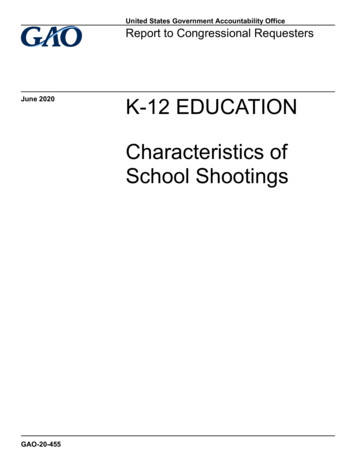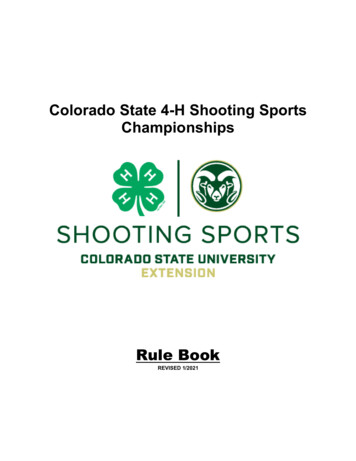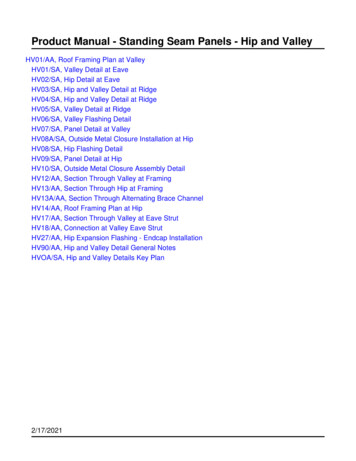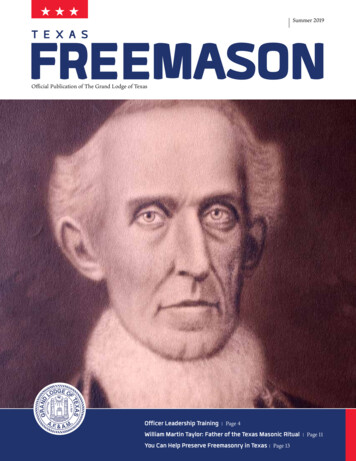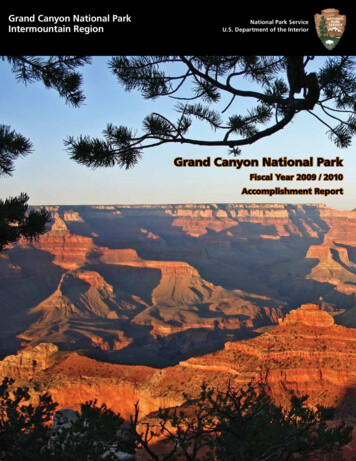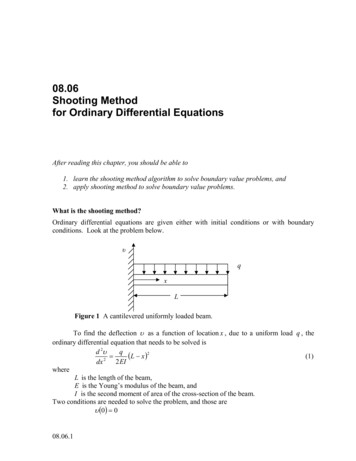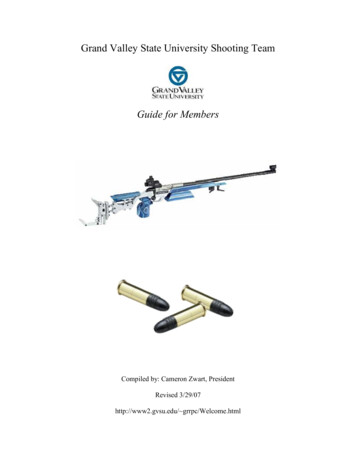
Transcription
Grand Valley State University Shooting TeamGuide for MembersCompiled by: Cameron Zwart, PresidentRevised 3/29/07http://www2.gvsu.edu/ grrpc/Welcome.html
INTRODUCTION:The purpose of the Grand Valley Shooting Team is to provide all Grand Valley studentswith the opportunity to enjoy rifle sports and shooting during the school year. Students with alllevel of skill are able to have a safe and enjoyable time at the shooting range interacting withother students and shooting. Some of the main focuses of the team are teaching and promotingfirearm safety and developing shooting skills. The team participates in monthly postal matches aswell as several weekend matches during the school year in the Western Intercollegiate RifleConference (WIRC), an eleven-college rifle league. Being a member of the WIRC allowsshooters to participate and compete in three position small-bore (.22 long rifle) and air rifle (.177pellet). Experience is not needed and all equipment, including rifles, is provided. Practice is heldat the Grand Rapids Rifle & Pistol Club (1331 Nagel SW, Wyoming), an indoor range with astate of the art air circulation system to keep the air fresh while shooting as well year roundclimate control. New members are always welcome. However, you must be enrolled at GVSUduring the current semester to join the team.2
FUNDING/DUES:The GVSU Shooting Team is a Student Life Club. A majority of the Team’s fundingcomes from the GVSU Student Life Department. Dues are also collected each semester and are for one practice day a week and for two practice days a week. A third source ofincome is through fundraising. Members decide fundraising techniques throughout the year.Upon paying dues a member is entitled to use of the range during practice hours,ammunition, targets, equipment, and rifle use. Their league entry fee is also paid to the WesternIntercollegiate Rifle Conference (WIRC). There is no additional out of pocket expenses forpostal matches.Out of pocket costs arise when there is a match that requires travel. There are severalmatches during each semester that require travel, such as the Boilermaker and the Finals Match.Personal equipment upgrades are also paid out of pocket to the shooter.There are currently no scholarships available for the Shooting Team.Upon paying dues new members must sign the Campus Life ‘Sports Release’ form. Thisform must be signed yearly.3
OFFICERS:The Shooting Team is entirely run by students with the assistance of a faculty adviser anda coach. There are four officer positions: President, Vice President, Treasurer, and Secretary.Individuals are elected to positions yearly. Officers are elected in spring semester and areinstalled during the following fall semester. All officers are provided with the opportunity to be aleader and it is a great way to develop leadership skills.Officers for the 2006-2007 school year are:President:Cameron Zwartcameroncody49426@aol.comVice President:George LovequistBoston George@comcast.netTreasurer:R. Ryan Phillipsphillirr@student.gvsu.eduSecretary:Spencer Flavinsflavin2@yahoo.comAdvisor:Brian Johnsonjohnsonb@gvsu.eduCoach:April Chernobychernoba@student.gvsu.edu4
PRACTICE:Practices are held Tuesdays 4-7 and Thursdays 6-9 at the Grand Rapids Rifle and PistolClub. Practice is encouraged but not mandatory. You must sign in prior to setting up on the readyline.THE RANGE:Located at 1331 Nagel Avenue SW in Wyoming, Michigan, the Grand Rapids Rifle andPistol Club has been the home of the Grand Valley State University Shooting Team since itsinception in 1996. The range is indoors and features twelve 50ft-shooting lanes. Each shootingpoint has its own personal bench for use. Air remains fresh, clean, and temperature appropriateyear round through a state of the art air purification system. In the lobby of the building there isample room for interaction and relaxation. There also are several storage compartmentsdedicated for exclusive use by the Grand Valley Shooting Team. These exist to allow students tokeep their equipment and/or rifle at the range when they are not using them.More information on the Grand Rapids Rifle and Pistol Club can be found atwww.grrpc.org5
THE WIRC:The WIRC is composed of eleven schools located in the Midwest. Schools compete inmonthly postal matches and an end of the year Finals Match. Some schools are Varsity programswhile others are Club programs.Member schools include:University of Akron, Morehead State, Grand Valley State, Rose Hulman Institute ofTechnology, Ohio State University, Univ. of Missouri-Kansas City, University of Michigan,Purdue University, Michigan State University, and University of Wisconsin Oshkosh.COMPETITION FORMAT:Three-position smallbore is shot in the prone, standing, and kneeling positions. Fourposition smallbore is shot in prone, standing, kneeling, and sitting. Air rifle is shot in standingonly. Indoor smallbore is shot at a distance of 50 feet and outdoor is shot at 50 yards. Air rifle isonly shot indoors at 10 meters. A three-position half course smallbore match is 60 shots, a fullcourse is 120 shots, and a four-position match is 40 shots. Air rifle is also 40 shots. In a halfcourse match, 20 minutes is allocated for prone, 40 minutes for standing, and 30 minutes forkneeling. All times are doubled in a full course match.6
MATCHES:GVSU VS. PURDUE SHOOTOUT:The GVSU vs. Purdue Shootout is shot every September at GRR&PC as the firstmatch of the year. This is a smallbore only match. The number of shooters determines thecourse of fire. Historically this has been a great rivalry. GVSU has been prevalent since2004.THE BOILERMAKER INVENTATIONAL:The Boilermaker Invitational is shot every October at Purdue University in WestLafayette, Indiana. Both smallbore and air rifle are shot. The number of shootersdetermines the course of fire. Approximately ten teams participate each year.WIRC POSTAL MATCHES:All the teams in the WIRC shoot postal matches monthly (October-January) attheir home range. The course of fire is half course. The targets, once shot, are mailed toan unbiased scorer who records the scores. All members of the team are allowed toparticipate in the matches individually. Four predetermined members of each teamrepresent the school and their scores are totaled together separately from everyone else’s.Individual and team scores are then ranked and results are distributed to the memberschools.WIRC FINALS MATCH:The WIRC Finals Match is shot every February. It is similar to the postal matchesexcept that all teams shoot on site, shoulder to shoulder. It is shot in half course format.7
NRA NATIONAL MATCHES:The NRA National Outdoor Rifle and Pistol Championships are held at CampPerry in Port Clinton, Ohio. Each summer the nation’s finest civilian and militarymarksmen and women square off for five weeks of rifle and pistol competition in avariety of formats and events. The National Matches are considered America’s “WorldSeries of the Shooting Sports”, and have been a tradition since 1907.THE SAINT JOSEPH VALLEY LEAGUE:The St. Joseph Valley League is comprised of rifle clubs from Michigan, Indiana,and Illinois. Each team is allowed to have as many shooters shoot as they wish. However,only the top four scores in each position count towards the final team score.The format for the league is 4 positions, indoors, and rifles may have any type of sights.There are 15 regular season matches and a Finals Match. The regular seasonmatches are duel matches shot on sight. The Finals match is shot on sight with allmember teams competing. The St. Joseph Valley League is not college specific, butrather open to all shooters.OTHER MATCHES:There is a variety of other local, state, and national matches shot through out theyear as well.8
EQUIPMENT:AMMUNITION BLOCK:An ammunition block is used by a shooter to hold ammunition while shooting.BLINDER:For shooters, it is important to keep both eyes open. The closing of the non-aiming eyeaffects the aiming eye and leads to fatigue in the eyes. For that reason a blinder is a necessaryaccessory for shooting. A blinder protects against light and glare. Many shooters feel theyhelp avoid distractions and aid in concentration.BOOTS:Shooting boots provide extra support in the standing and kneeling positions. A goodshooting boot will give ankle support as well. If shooting boots are unavailable, a hard soleshoe or boot will suffice.EYE PROTECTION:Safety glasses are designed to prevent foreign matter from entering your eyes. They areusually inexpensive and should be worn any time there is an opportunity for something toaccidentally enter your eye.GLOVE:A shooting glove helps to cushion the hand from the stock and sling, shield the rifle fromyour pulse, and provide a non-slip surface for traction. It should be comfortable without extrabulk. A shooting glove should be loose fitting and not pinch the hand. If it does pinch thehand, it will have an effect on your shooting over the length of a match. The 5-fingershooting glove is far and away the most popular worldwide.9
HEADBAND/HATShooters should wear a shooting cap or headband when shooting. Both help avoiddistractions that can take points off your score.Special shooting caps have a longer bill than regular caps and side flaps that extend downfrom the bill. This helps shooters maintain concentration by concealing possible distractionsand keeping sunlight and glare from their eyes.The headband keeps sweat and hair from getting in the shooter’s eyes, and some shootersuse it to hold a blinder over the non-aiming eye.HEARING PROTECTION:Your hearing is very important to you. The noise from smallbore rifles can damage yourhearing, especially over a long period of time. Whenever you are shooting or observing,always wear hearing protection.Some recommend using both the “throw away” earplugs and earmuffs for greater noisereduction. Both the plugs and muffs must be worn properly for maximum protection. Themuffs are only as effective as the seal they make with the head. Shooting glasses, especiallyones with thick frames, break this seal and hold the muff slightly away from the head, as cansweatbands.It is critical to a shooter’s performance that noise and distractions be kept to a minimum.Hearing protection will help do this. Therefore, it may be beneficial to wear hearingprotection when shooting air guns even though noise levels are not dangerous.10
JACKET/PANTS:Shooting jackets and pants provide extra support for the shooter. They help reduce theeffect of pulse on the rifle while providing as much support as possible.Shooting jackets traditionally have been made of leather for durability although someshooters prefer the stiffer canvas jackets. They have a hook on the left sleeve (right-handedshooters) to attach to the sling and keep it from slipping.Shooting pants have traditionally been made of canvas although leather pants areavailable.KNEELING ROLL:A good kneeling roll will give the shooter proper support and allow for a comfortable,steady position in kneeling. The kneeling roll must conform to the shooter’s instep. Akneeling roll can be stuffed with several different materials. The material you choose mustallow the roll to be flexible enough to fit your instep but not too flexible as to compromisesupport.MAT:A shooting mat will help keep you dry and make your firing point more comfortablewhen shooting prone. A mat provides non-slip surfaces for your elbows to give you a morestable position.11
PALM REST:The palm rest is used for moving the rifle stock up to the level of the head. Some shooterscan accomplish this without the use of a palm rest. They simply support the rifle with thehand. Others use a small block of wood. A most important point is that the correctpositioning of the body is assumed, and then the rifle is fitted to the body, not the body to therifle. The palm rest is positioned in the heel of the hand, and the wrist is reviewed for itscorrectness of position and shooting athlete comfort.SCORING GAUGE:Targets require scoring and scoring devices. A scoring gauge is a metal device the samesize as the shot hole, used to score targets. Variations include the "inward plug" and "outwardplug." With the inward plug, the score is determined by the contact point of the outside edgeof the plug with the inside of the next lowest scoring ring. With an outward plug, the score isdetermined by the contact point of the outer edge of the plug with the inside of the scoringring. An outward scoring gauge is the most accurate tool to use to score a paper target.Unfortunately, it is only usable on certain targets and each gauge must be designed for thattarget. It is the most accurate gauge because it measures against a scoring ring that has notbeen disturbed by a bullet hole. The key is to look at the shot and decide what you arelooking for. You can tell immediately if the shot is a close nine or a wide seven. If it is aclose shot, put the outward gauge in the hole and look at the outward edge. With an outwardscoring gauge, if the gauge is tangent to the outer edge of the scoring ring or closer to thecenter, the shooter gets the higher value. You will not see any white when the plug is trulytangent to the scoring ring.12
SLING:The purpose of the shooting sling is to support the weight of the rifle. The differences inslings are the cost and convenience to the shooter. A sling cannot be used in standing.SHOOTING STAND/OFF HAND STAND:The shooting stand is used to rest the rifle between shots when shooting in the standingposition. By resting the rifle on the stand between standing shots, shooters can rest theirmuscles and not tire as quickly. By placing the stand close by, shooters use the least exertionpossible to pick up the rifle for each shot. The stand also positions the ammo in the mostconvenient location for standing. The shooting stand consists of telescoping tubes that can becollapsed. At a short height, the stand is perfect to hold ammunition for kneeling. This meansthat shooters can complete a match with minimal movement in their position between shots,which allows for greater consistency.SPOTTING SCOPE:The spotting scope is used to locate your shots on the target for sighting purposes and toevaluate your shooting performance. When shooting outdoors it can help in determiningwind direction by allowing you to observe mirage. If you shoot primarily outdoors, wherelighting varies with weather conditions, distances are 50 yards or more and greater clarity isrequired to see mirage, you will want to consider a scope with a fairly large objective lens(either 82mm or 60mm). If you shoot mostly indoors, where distances are 50 and 75 feet, a50mm objective lens scope will be adequate.Most shooters prefer the offset or angled spotting scopes because those scopes do notrequire the shooters to move from their position as much as a straight scope does.13
SPOTTING SCOPE STAND:A scope stand that is adjustable for height is essential for all shooting positions, includingprone. A properly located spotting scope will allow shooters to spot their shots withoutmoving their positions.14
AMMUNITION:SMALLBORE:There is a great deal of difference between match ammunition and ordinary .22s boughtat a local discount store. Match ammo is designed for one specific purpose--to deliver thebest accuracy under match conditions. Ordinary .22 ammo is designed for a multitude ofpurposes such as functioning in different types of actions, ease of manufacturing and lowcost. A target shooter attempting to train with ordinary ammo may find the initial cashsavings to be counter-productive to progress and definitely not cost effective in the long run.Ammo that is not accurate enough to deliver the shot the shooter fired does not allow theshooter to properly evaluate performance and can destroy confidence in their ability to callshots. Shooters will progress faster with fewer shots of better ammunition.Members of GVSU Shooting Team are provided with SK Standard .22 caliber long rifle,rimfire ammunition.AIR RIFLE:Pellets are now only available in bulk packed in tins. The shooter both must inspectpellets from tins visually and by feel to avoid pellets with imperfections. The pellets thataren’t perfect must be discarded. For best results in competition, you should open a freshcontainer immediately prior to your relay. Pellets oxidize from exposure to the atmosphere,and as a result accuracy will deteriorate. It is important to reseal pellet containers afteropening.Members of GVSU Shooting Team are provided with RWS Meisterkugeln .177 caliberpellets.15
TARGETS:A-17:The A-17 target is used in indoor four-position smallbore. This is the target used in theSaint Joseph Valley League.A-36:The A-36 target is used in indoor three position. This is the target formerly used in theWIRC.16
USA/NRA 50:The USA/NRA target is used in college indoor three position and is the official target ofUSA Shooting. This is the primary smallbore target used by the GVSU Shooting Team.AR 5/10:The AR 5-10 target is used for air rifle. This is the air rifle target used by the GVSUShooting Team.17
A-51:The A-51 target is used in outdoor three position.18
SMALLBORE RIFLES:A majority of the rifles used by the GVSU Shooting Team are made available through apartnership with the Grand Rapids Rifle and Pistol Club. However, many members do own anduse their own rifles. All rifles are single shot, bolt-action rifles with aperture sights. Iron sights ormetallic sights are the only sights allowed in the WIRC. A hand stop is used in prone, kneeling,and sitting. A palm rest is used in standing.Typical rifles used include those made by Anschuetz, Feinwerkbau, along with a fewmodels from Remington, Winchester, Mossberg, and others. Prices vary considerably, from 200-300 on up to the 4000 range.Telescopic sights are allowed for Any Sight matches, but you might be surprised howaccurate good metallic sights are. If you can't shoot a good score with iron sights you probablywon't be able to do so with a scope either. The scope may help with sight alignment, but it can'thelp with trigger control and a good hold.AIR RIFLES:The GVSU Shooting Team owns five Walther LG300XT aluminum stock air rifles.Several members also own their own rifles. Most air rifles, including the rifles owned by theShooting Team function through the use of compressed air, although some function through theuse of a spring. Competition air rifles must have metallic or aperture sights. A hand stop or apalm rest cannot be used in air rifle. Slings also may not be used in air rifle.19
SIGHTS:Target aperture sights are designed for maximum precision, and the rear sight is usually alarge disk (up to 1 inch or 2.5 cm in diameter) with a small hole in the middle, and placed closeto the shooter's eye. The front sight may be a simple bead or post, but is more often a globe typesight, which consists of a cylinder with a threaded cap, which allows a number of differentlyshaped front sights to be used. Most common are posts of varying widths and heights or rings ofvarying diameter — these can be chosen by the shooter for the best fit to the target being used.Tinted transparent plastic inserts may also be used, with a hole in the middle; these work thesame way as an opaque ring, but provide a less obstructed view of the target. Even for themaximum precision, there should still be a significant area of white visible around the bullseyeand between the front and rear sight ring (if a front ring is being used). Since the best key todetermining center is the amount of light passing through the apertures, a narrow, dim ring oflight can actually be more difficult to work with than a larger, brighter ring. The precise sizes arequite subjective, and depend on both shooter preference and ambient lighting, which is whytarget rifles come with easily replaceable front sight inserts, and adjustable rear apertures.By turning the elevation dial on the rear sight clockwise the point of impact is lowered.By turning the elevation dial counterclockwise the point of impact is raised. A clockwise turn ofthe windage dial will move the point of impact to the left. A counterclockwise turn of thewindage dial will move the point of impact to the right.20
PRONE POSITION:PREPERATION:The prone position is thought to be the easiest position of the three. Placing the mat onthe firing position or point starts the prone position, the mat is placed at an angle facing orpointing 10-20 degrees to the right of the target. The upper left corner of the mat will then bepointing to the target center. Place the spotting scope between the firing line and the leftshoulder position while in firing and position. This will allow the athlete to view the targetwhile charging the rifle. Place the ammo block to the right of the firing position between theright shoulder and hips at a comfortable position. All other items required by the athlete canbe placed to the right of the shooting position but not in such a manner as to disrupt theathlete next to you. Do not place items of equipment on or forward of the firing line duringlive fire or competitions.TAKING THE POSITION:The body is in contact with the ground, and the low center of gravity of the bodyproduces a very stable position. A major amount of patience and concentration will berequired before observable results and consistent scores are achieved. The prone position isnot hard to develop, however, care must be taken as to the placement of the mass of weight.For this position, the majority of the weight must be found on the left side for right-handedshooters and on the right for left handed shooters. The placement of the weight mass on theleft or right side will take pressure off the stomach and chest areas. On the side away fromthe weight mass, the right side becomes an outrigger so to speak and will be used forstabilizing the overall position during the shooting technique. By placing the weight mass on21
the left or right side the heart will not impart a heartbeat to the position during the firingsequences.BODY:The body stretched out at an angle of about 5 to 10 degrees alignment direction of theright of the target and the right knee is slightly bent. If the shoulders, backbone, and hips areawkwardly positioned, cramps will occur or muscles will be overly stressed causing a snaprelease upon the firing of the rifle, and resulting in flipping the rifle off the sighted targetbull. The backbone or spine and the shoulders must be at right angles. The body weight lieson the left side of the body. This makes breathing easier and prevents the pulse transmissionfrom the abdominal area to the bone structure. By drawing the right leg up, the body is turnedtoward the left side, freeing the chest and stomach from the ground. This makes itunnecessary for the body to raise and lower during the breathing cycle. Basically, the bodyweight is on the left side, and the aorta, the main artery from the heart, is moved from thespine so internal pulse beat is not transmitted directly to the bony portions of the body. Thisresults in less movement of the body and the rifle. If the knee is brought up too far (90degrees), too much pressure will be placed on the left elbow.LEGS:The legs should spread loosely and without tension. The left leg will be straight but theright leg will be bent and drawn up 35 degree in order to ease the pressure on the stomachand stabilize the position. The inside of the right knee is placed upon or against the mat. Theright leg is drawn up and both feet are pointed toward the right. The shooter lies to the left ofthe line of fire with the body forming a 5 to 15 degree angle from the line of fire. The bodyis not twisted, but is stretched out and relaxed; the spine is straight.22
FEET:The position of the feet is determined by the position of the body. The left foot must turninward with the outside of the foot resting on the floor or mat. The right foot should rest withthe instep pressing lightly against the floor. It is immaterial whether the heel is on theground,LEFT ARM:The weight of the rifle is supported by the left forearm, which is placed directly belowand slightly to the left of the rifle. The left elbow is pushed forward, giving a flat, extended,and therefore stable body position. The angle of the forearm must not be less than 30degrees. The central load bearing point is below and slightly to its left of the rifle. Thisproduces a well-balanced, triangular position in a natural and relaxed position. However, ifthe full left elbow is forced directly below the rifle, excess tension will occur in the upperarm and shoulder. Any changes in the elbow position during shooting will mean changes inthe point of impact have occurred. The athlete will find that the elbow will move during theshooting process and will destroy the sighting process and cause the position to becomeunstable during the shooting procedure. The left elbow is not directly under the rifle. It isslightly to the left of the rifle. When viewed from above, the left leg, left side, shoulder,elbow and wrist, all appear to be a straight line. The Prone position requires the left forearmto angle at not less than 30 degrees from sling hand stop and continuing to a point on thefloor where the elbow make contact with the floor23
LEFT HAND:The front of the rifle stock rest on the ball of the thumb of the left hand. The fingers arecompletely relaxed and should not grip the weapon. Even the smallest irregular pressurefrom the fingers on the stock or barrel can produce a change in the point of impact. The lefthand is pushed forward as far as the rifle hand stop. This means the stock is securely heldand will not slip during the shooting process. In both prone and kneeling positions, the lefthand is pushed against the hand stop. The fingers must never grip the fore stock. If hand isplaced too far forward the arm muscles will be called upon to support the rifle while in anextended posture. This will induce fatigue and pain. If the hand is too far to the rear, theshoulders and chest will be raised with an uneven weight on the elbows. The rifle must besupported by the bone structure and sling. In actual fact the rifle is totally supported by thesling. The rifle is placed across the heel of the hand and the base of the thumb ball, to takeadvantage of and originate bone-to-bone support.RIFLE SLING:Without a sling the left arm supports 92% of the weight of the rifle. Without additionalsling support, and despite the support provided by the forearm, the rifle could only bemaintained in the firing position by sheer muscular strength. The rifle sling forms a stabletriangle as it joins the left arm, the forearm and the stock, thereby imparting the requireddegree of stability to the shooting position. When putting on the sling, the athlete must makesure the pulse effect from the upper arm is not transmitted through the sling to the rifle. Theathlete will fit the sling loop above the upper arm muscle. For the sling to fit properly abovethe upper arm muscle, the athlete must wear a proper fitting-shooting jacket with a suitablesling-retaining loop. The supporting effect makes the position stable and the sling will ease24
the muscle fatigue while supporting the rifle and position. It also ensures the head is uprightincreasing the stability of the position and sighting system. If the rifle sling slips lower onthe arm during competition, it may press on a main artery and the pulse will be transmittedthrough the sling to the rifle. Upon the sling slipping, the sling assumes the lower slingposition and this arrangement reduces the angle of the position, often becoming close in andviolating the rule of 30-degree angle of the left arm in the prone position. The shooter whotries to make up for the increase in stability with renewed muscular effort, which is just badshooting procedure. The length of the athlete’s arms will determine the point on front of thestock at which the rifle sling and hand stop will be located and attached. The hand stop mustnot be allowed to move during shooting or competition. The sling passes around the leftforearm. This means there is no transfer of pulse effect to the upper arm and the tension isexerted directly backwards rather than to the side. The sling length is adjusted in such a waythe rifle is held securely and effortlessly in the firing position. If the sling is too long, thefiring position will be too low and too limp. If it is too short, it will press the shoulderbackwards and affect the circulation of blood. This will result in an increased pulse and painin the left hand, arm, and shoulder.RIGHT SHOULDER:A few athletes neglect the importance of the rifle and right shoulder position relationship.This is wrong, as any variations of location or of pressure on the butt, plate will inevitablyresult in changes in the point of impact. As described above, the ideal position is theshoulder placed at right angles to the spine. The rifle butt must be positioned at the samepoint each and every shot as its relationship to the shoulder is in fact the fulcrum of the riflein relation to muzzle jump or other recoil movements.25
RIGHT ARM:The elbow is slightly to one side and the position is flat and stable. The shoulder isbehind the weapon. The right elbow is relaxed and pushed forward, but slightly to the rightin a comfortable position. The actual distance from the body is determined by the position ofthe body. The athlete will not allow the arm to move back towards the body; otherwise, theshoulder will be at an unnatural angle and will be cramped.RIGHT HAND:The right hand must not exert lateral pressure on the rifle stock. The degree of firmnessused will depend upon the manner of firing, the trigger resistance the individual firingtechnique. If trigger pull resistance is high, the athlete will grip the rifle firmly and if thetrigger pull resistance
Pistol Club has been the home of the Grand Valley State University Shooting Team since its inception in 1996. The range is indoors and features twelve 50ft-shooting lanes. Each shooting point has its own personal bench for use. Air remains fresh, clean, and temperature appropriate year round through a state of the art air purification system.
